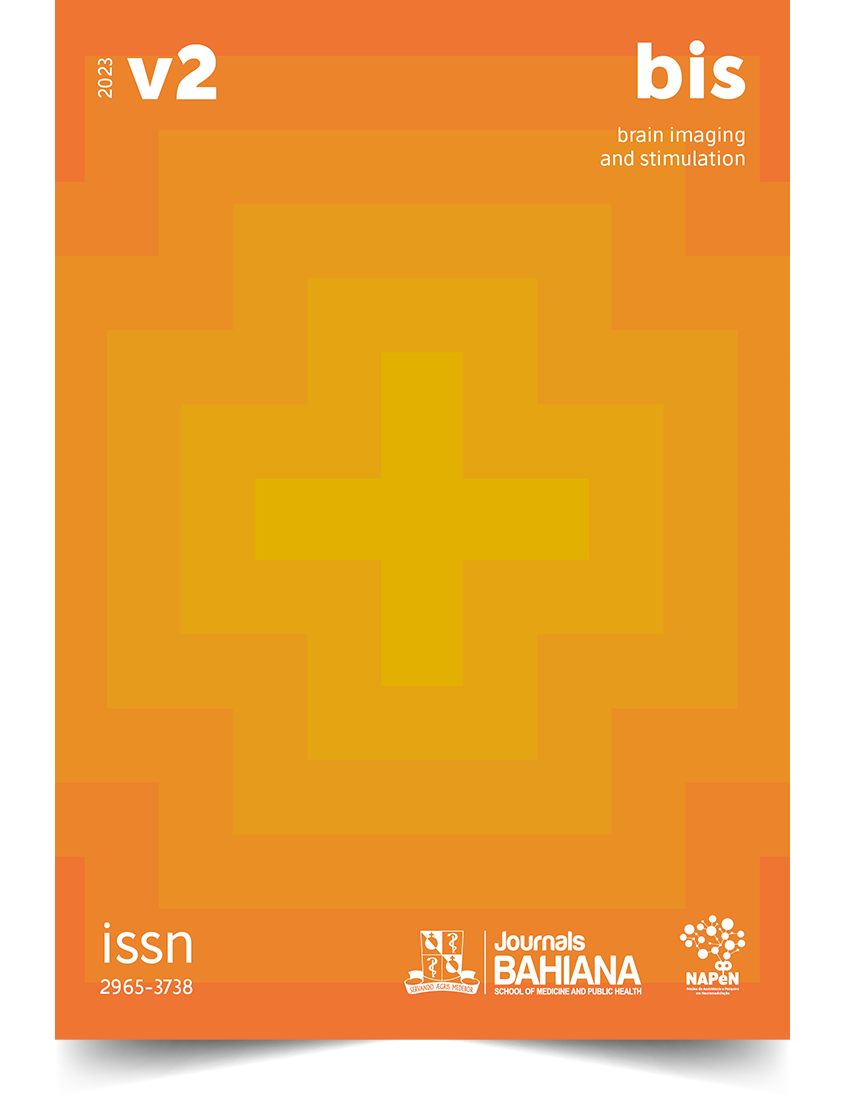Femoral cortical excitability differs between people with knee osteoarthritis and healthy controls: a pilot study
DOI:
https://doi.org/10.17267/2965-3738bis.2023.e4817Keywords:
Cortical Excitability, Evoked Potentials, Motor, Osteoarthritis, Knee, Quadriceps MuscleAbstract
BACKGROUND: Knee osteoarthritis (OA) is associated with changes in corticospinal and intracortical excitability which may be due to persistent pain. OBJECTIVE: To investigate the cortical excitability profile of the femoral quadriceps in people with knee OA and healthy volunteers. METHODS: Cortical excitability was assessed using transcranial magnetic stimulation (TMS) in 7 participants with knee OA and 6 age- and sex-matched healthy volunteers. The motor evoked potential (MEP), cortical silent period (CSP), short intracortical inhibition (SICI) and intracortical facilitation (ICF) of the rectus femoris (RF), vastus medialis (VM) and vastus lateralis (VL) were measured using standard single pulse and paired-pulse TMS techniques. Data analysis was performed using Mann-Whitney test considering alpha <0.05. RESULTS: Participants with knee OA demonstrated reduced MEP amplitude in the RF and VM muscles and augmented MEP amplitude in the VL muscle. SICI was reduced only in the RF and ICF was reduced in the VM and VL. CSP was reduced in all muscles. CONCLUSION: People with knee OA exhibit altered corticospinal and intracortical excitability profile in specific portions of the quadriceps muscle. This suggests a possible adaptive strategy to maintain quadriceps motor activity.
Downloads
References
(1) Litwic A, Edwards MH, Dennison EM, Cooper C. Epidemiology and burden of osteoarthritis. Br Med Bull. 2013;105(1):185–99. https://doi.org/10.1093/bmb/lds038
(2) Palmieri-Smith RM, Villwock M, Downie B, Hecht G, Zernicke R. Pain and effusion and quadriceps activation and strength. J Athl Train. 2013;48(2):186–91. https://doi.org/10.4085/1062-6050-48.2.10
(3) Liikavainio T, Lyytinen T, Tyrväinen E, Sipilä S, Arokoski JP. Physical function and properties of quadriceps femoris muscle in men with knee osteoarthritis. Arch Phys Med Rehabil. 2008;89(11):2185–94. https://doi.org/10.1016/j.apmr.2008.04.012
(4) Rice DA, McNair PJ. Quadriceps arthrogenic muscle inhibition: neural mechanisms and treatment perspectives. Semin Arthritis Rheum. 2010;40(3):250–66. https://doi.org/10.1016/j.semarthrit.2009.10.001
(5) Pietrosimone BG, McLeod MM, Lepley AS. A theoretical framework for understanding neuromuscular response to lower extremity joint injury. Sports Health. 2012;4(1):31–5. https://doi.org/10.1177/1941738111428251
(6) Mizner RL, Petterson SC, Stevens JE, Vandenborne K, Snyder-Mackler L. Early quadriceps strength loss after total knee arthroplasty. The contributions of muscle atrophy and failure of voluntary muscle activation. J Bone Joint Surg Am. 2005;87(5):1047–53. https://doi.org/10.2106/JBJS.D.01992
(7) Guilak F. Biomechanical factors in osteoarthritis. Best Pract Res Clin Rheumatol. 2011;25(6):815–23. https://doi.org/10.1016/j.berh.2011.11.013
(8) Balaguer-Ballester E. Cortical Variability and Challenges for Modeling Approaches. Front Syst Neurosci. 2017;11:15. https://doi.org/10.3389/fnsys.2017.00015
(9) Hunt MA, Zabukovec JR, Peters S, Pollock CL, Linsdell MA, Boyd LA. Reduced quadriceps motor-evoked potentials in an individual with unilateral knee osteoarthritis: a case report. Case Rep Rheumatol. 2011;2011:537420. https://doi.org/10.1155/2011/537420
(10) Lewek MD, Rudolph KS, Snyder-Mackler L. Quadriceps femoris muscle weakness and activation failure in patients with symptomatic knee osteoarthritis. J Orthop Res. 2004;22(1):110–5. https://doi.org/10.1016/S0736-0266(03)00154-2
(11) Tarragó MGL, Deitos A, Brietzke AP, Vercelino R, Torres ILS, Fregni F, et al. Descending Control of Nociceptive Processing in Knee Osteoarthritis Is Associated With Intracortical Disinhibition: An Exploratory Study. Med (Balt). 2016;95(17):e3353. https://doi.org/10.1097/MD.0000000000003353
(12) Shanahan CJ, Hodges PW, Wrigley TV, Bennell KL, Farrell MJ. Organisation of the motor cortex differs between people with and without knee osteoarthritis. Arthritis Res Ther. 2015;17:164. https://doi.org/10.1186/s13075-015-0676-4
(13) Kittelson AJ, Thomas AC, Kluger BM, Stevens-Lapsley JE. Corticospinal and intracortical excitability of the quadriceps in patients with knee osteoarthritis. Exp Brain Res. 2014;232(12):3991–9. https://doi.org/10.1007/s00221-014-4079-6
(14) Caumo W, Deitos A, Carvalho S, Leite J, Carvalho F, Dussán-Sarria JA, et al. Motor Cortex Excitability and BDNF Levels in Chronic Musculoskeletal Pain According to Structural Pathology. Front Hum Neurosci. 2016;10:357. https://doi.org/10.3389/fnhum.2016.00357
(15) Groppa S, Oliviero A, Eisen A, Quartarone A, Cohen LG, Mall V, et al. A practical guide to diagnostic transcranial magnetic stimulation: report of an IFCN committee. Clin Neurophysiol. 2012;123(5):858–82. https://doi.org/10.1016/j.clinph.2012.01.010
(16) Rossini PM, Burke D, Chen R, Cohen LG, Daskalakis Z, Di Iorio R, et al. Non-invasive electrical and magnetic stimulation of the brain, spinal cord, roots and peripheral nerves: Basic principles and procedures for routine clinical and research application. An updated report from an I.F.C.N. Committee. Clin Neurophysiol. 2015;126(6):1071–107. https://doi.org/0.1016/j.clinph.2015.02.001
(17) Hallett M. Transcranial magnetic stimulation: a primer. Neuron. 2007;55(2):187–99. https://doi.org/10.1016/j.neuron.2007.06.026
(18) Škarabot J, Mesquita RNO, Brownstein CG, Ansdell P. Myths and Methodologies: How loud is the story told by the transcranial magnetic stimulation-evoked silent period? Exp Physiol. 2019;104(5):635–42. https://doi.org/10.1113/EP087557
(19) Parker RS, Lewis GN, Rice DA, McNair PJ. Is Motor Cortical Excitability Altered in People with Chronic Pain? A Systematic Review and Meta-Analysis. Brain Stimul. 2016;9(4):488–500. https://doi.org/10.1016/j.brs.2016.03.020
(20) Te M, Baptista AF, Chipchase LS, Schabrun SM. Primary Motor Cortex Organization Is Altered in Persistent Patellofemoral Pain. Pain Med. 2017;18(11):2224–34. https://doi.org/10.1093/pm/pnx036
(21) Hermens HJ, Freriks B, Disselhorst-Klug C, Rau G. Development of recommendations for SEMG sensors and sensor placement procedures. J Electromyogr Kinesiol. 2000;10(5):361–74. https://doi.org/10.1016/s1050-6411(00)00027-4
(22) Lotze M. Maladaptive Plastizität bei chronischen und neuropathischen Schmerzen. Schmerz. 2016;30(2):127–33. https://doi.org/10.1007/s00482-015-0080-7
(23) Baliki MN, Mansour AR, Baria AT, Apkarian AV. Functional reorganization of the default mode network across chronic pain conditions. PLoS One. 2014;9(9):e106133. https://doi.org/10.1371/journal.pone.0106133
(24) Mueller S, Wang D, Fox MD, Thomas Yeo BT, Sepulcre J, Sabuncu MR, et al. Individual Variability in Functional Connectivity Architecture of the Human Brain. Neuron. 2013;77(3):586–95. http://dx.doi.org/10.1016/j.neuron.2012.12.028
(25) Sparing R, Buelte D, Meister IG, Paus T, Fink GR. Transcranial magnetic stimulation and the challenge of coil placement: a comparison of conventional and stereotaxic neuronavigational strategies. Hum Brain Mapp. 2008;29(1):82–96. https://doi.org/10.1002/hbm.20360
Downloads
Published
Issue
Section
License
Copyright (c) 2023 Kamyle Villa-Flor Castro, Rafael Jardim Duarte-Moreira, Cleber Luz-Santos, João Cavalcanti, Diana Noronha, Janine Ribeiro Camatti, Katia Nunes Sá, Alexandre Okano, Michael Lee, Abrahão Fontes Baptista

This work is licensed under a Creative Commons Attribution 4.0 International License.
This work is licensed under a Creative Commons Attribution 4.0 International License.



